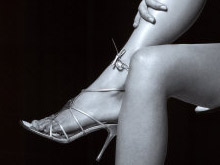Health Topics
-
Healthy Living
-
|
|
February 2010
|
| Something Corny Corns and Calluses |
| Dr Anshul Warman |
| |
 |
Do you know the secret of well-sculpted bodies of stars like Akshay Kumar and Bipasha Basu? It's Kung Fu. The ancient martial art is the wondrous new way to keep fit Corns and calluses are remains of what happened on your skin in the past, which caused it to harden up. Here's what you can do to help your skin get a new beginning.
|
A corn is a localised area of thickened skin occurring at locations of constant friction, rubbing or pressure. Hard corns occur on dry, external aspects of the foot, whereas soft corns are found between toes and may be macerated from perspirations.
A callus (callosity) is an area of hard, dead skin up to an inch wide on the soles of the feet, the palms of the hands, or any area subject to friction. Corns generally occur on the toes and balls of the feet, while calluses can develop on hands, feet, or anywhere where there is friction.
| 7 Causes of Corns and Calluses |
Certain types of work and sports can often cause calluses. Callus develops on the hands of tennis and baseball players and labourers, on the soles of the feet of joggers, and on the fingertips of guitarists and violinists. The usual culprits are:
- New, tight, or poorly fitting shoes
- Sandals or shoes worn without socks, which lead to friction
- High-heeled shoes
- High arches in your feet that put pressure on the tips of the toes when you walk
- Any physical deformity that distributes your weight unevenly when you walk
- Protruding bones or not enough flesh to cushion the bones of your feet
- Repetitive trauma, in athletes
|
Corn vs. Callus
Chronic pressure and friction due to ill-fitting footwear, bony prominences, or repetitive athletic activity result in thickening of upper layers of skin. While a callus forms when pressure forces are broadly distributed, a corn forms when the pressure is localised in a small area. Corns are generally more painful when pressed vertical to the skin surface, whereas warts are more tender when squeezed laterally between the finger and thumb.
The major difficulties with diagnosis lie with foot callosities. The patient's footwear, gait and alignment of the feet are examined.
Your dermatologist would diagnose a corn by clinical appearance, often aided by paring the surface with a surgical blade. These occasionally painful spots present as well-defined, firm areas with a central translucent thick core. A callosity is a diffused thickening of the skin due to broadbased friction or pressure, which lacks the central core characteristics of a corn. An orthopaedician's opinion or a plain X-ray of the foot to look for bony abnormalities underlying persistent or recurrent corns may be recommended by your dermatologist.
| 6 Ways to Take Care |
- Corns and calluses will disappear when the friction or excess pressure goes away. Wear loose-fitting and comfortable shoes. Leather usually moulds with the foot better than synthetic materials.
- Over-the-counter ointments and topically applied corn plasters would be helpful, but care should be taken about the healthy tissue surrounding the corn. Consult the pharmacist if you have any doubts or questions about proper use of the ointment.
- Soak yourself in a bath to soothe and soften the skin, and then use a file, pumice stone or towel to rub over the corn and soften it. Repeat this until the corns or calluses disappear. Wear a protective pad over the area to keep the growth from returning.
- Use a chemical preparation as prescribed by your doctor to dissolve or burn away the excess skin.
- Apply hydrocortisone with antibiotic cream or a calendula-based ointment on a cracked callus. Aloe cream is also good for soothing and healing the skin.
- Elevate your feet and expose them to fresh air whenever possible.
Note: Try these measures only if your general health is good. Diabetics and elderly patients should consult their doctor first. |
Preventing Corns
Prevention is important because lesions will persist until the underlying cause is removed. Paring down the surface with a scalpel blade relieves pain in the short term. Hard corns can be softened with salicylic acid preparations (10 – 40 percent) prescribed by your dermatologist, or by a procedure called cryotherapy. It is important to ensure that the salicylic acid plasters correspond exactly to the size of the corn so as to minimize damage to the surrounding skin. These should be used cautiously in people with peripheral nerve diseases like diabetics etc as they may fail to notice pain from improperly placed patches. Your doctor may also suggest other helpful agents like petroleum, urea, lactic acid, topical antibiotics, moisturisers etc.
- Buy comfortable and appropriate shoes.
- Beware of tight, high-heeled shoes. Even if you wear high-heels, try to take them off whenever possible during the day to give your feet rest.
- Wear comfortable shoes to work.
The role of your shoes in producing callosities should be carefully assessed and corrective steps taken to reduce friction. Extra width may be needed, especially in the toe area; or maybe, a softer upper surface. With marginal calluses, the shoe is likely to be too loose. The shoe may need to be adapted to receive a cushioning device designed to redistribute the mechanical forces causing the callosity.
With treatment, corns and calluses usually go away in one to four weeks after stopping the activity that caused the friction or after discarding the shoes that caused the problem. The location and nature of the growth affect the rate of healing. Without treatment, they may last indefinitely, though. |
 |
Dr. Anshul Warman is Consultant Dermatologist & Cosmetologist at Apollo Hospitals, Ahmedabad |
|
|